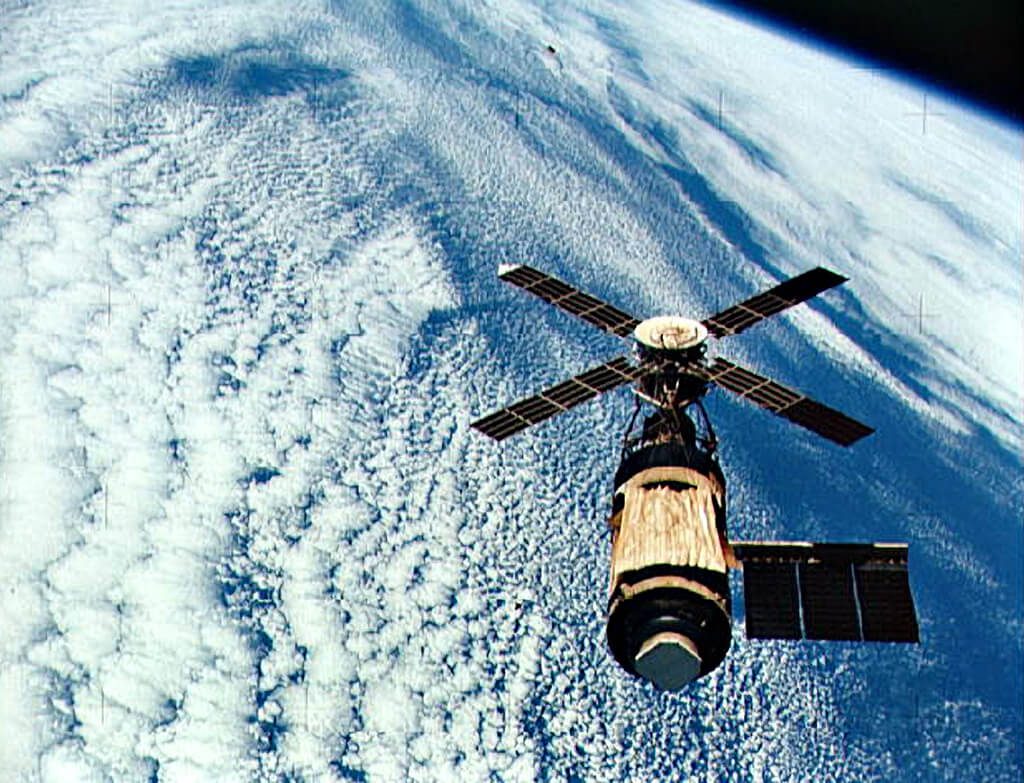Keraunothnetophobia, as defined by some online dictionaries, is the fear of falling artificial satellites and other space objects. It is not to be confused with Keraunophobia, the fear of lightning strikes.
Although often regarded as especially irrational, Keraunothnetophobics’ fears turned out to be partly justified when a 1 kg object from the International Space Station (ISS) crashed through the roof and two floors of the Otero family home in Naples, Florida, in March. Luckily no one was hurt but the family were understandably stunned and have alleged that the ISS object nearly hit one of them. It is likely that NASA will face a claim for third-party damage.
“Keraunothnetophobia”
noun
pronounced kee-ran-o-net-o-fow-bee-uh, (we think)
an exaggerated fear of being struck by artificial satellites
Note: The term has not yet been formally recognised by major dictionaries such as the Oxford English Dictionary

The ISS robot arm release of the EP-9 Pallet with its discarded batteries aboard. Courtesy: NASAEarlier this month NASA confirmed that the object was the surviving piece of an EP-9 pallet, which had nickel hydride batteries on top. The pallet had been discarded by astronauts, using the ISS Canadarm-2 robot arm, on 11 March 2021. It had re-entered Earth’s atmosphere over the Gulf of Mexico at 1929 GMT on 8 March, between Cancun and Cuba (times and location are according to orbital analyst and astrophysicist Jonathan McDowell). At the time of its release, McDowell warned that, given its mass, debris from the truss and batteries might survive a later uncontrolled destructive re-entry.
Items that survive re-entry are usually large and made of heat-resistant materials such as stainless steel. Round or circular cross-section tanks or parts are also more likely to survive due to having lower airflow induced thermal heating than sharper objects.
In this instance, the object had a circular cross section and was made of Inconel, a high temperature alloy. Investigators were thus able to identify it as a stanchion used to mount the batteries on the cargo pallet.
Hello. Looks like one of those pieces missed Ft Myers and landed in my house in Naples.
Tore through the roof and went thru 2 floors. Almost his my son.
Can you please assist with getting NASA to connect with me? I’ve left messages and emails without a response. pic.twitter.com/Yi29f3EwyV— Alejandro Otero (@Alejandro0tero) March 15, 2024
So, is this fear irrational?
Most strikes on houses, or in one case a human, have involved rocket stages dropped off during launch. Of the 80 instances of third-party damage caused by falling space objects, recorded on the Seradata launch and satellite database, there are only six instances where hardware survived re-entry from orbit to cause damage on land.
Unsurprisingly, the instances when falling space debris have been proven to originate from re-entering space hardware have become famous. During its re-entry in 1979, parts of the Skylab space station were strewn over the town of Esperance in western Australia. NASA was even fined AUS$400 for its littering, although the US space agency never paid it off. Instead, a radio DJ paid it on NASA’s behalf 30 years later.
More serious incidents include the earliest one in the table when Russian satellite Cosmos 954 spilled a substantial amount of its nuclear powerplant material over Canada during re-entry in 1978.
In February 2003, the re-entry failure (induced by launch damage) of the STS-107 Columbia space shuttle orbiter resulted in several claims for property damage. Some 66 claims were paid out by NASA for third-party damage caused by falling debris, including for loss of cattle and a damaged glass-covered table. The total came to less than US$500,000.

The original Skylab space station of the early 1970s was surprisingly successful. Courtesy: NASA
Thankfully, no human has been killed by a piece of hardware falling from orbit…yet. However, there is evidence that a woman was hit by an item from an orbiting Delta II rocket stage. Lottie Williams, 48, was exercising in Tulsa Park, Arizona, on 22 January 1997, when she was hit by a blackened six-inch piece of the rocket, but she walked away from the incident. The rocket had been used to launch the Midcourse Space Experiment in April 1996.
Nevertheless, the chance of being killed by falling space objects is extremely low – estimated at one in a trillion. Scientific studies have shown that fears of falling space objects are disproportionate to the actual risk of it happening, at least when compared with other personal risks.
This does not mean that falling space hardware poses no risk – but it is the strikes from natural space objects that humans should look out for. For example, while the probability is low, large asteroid and comet strikes such as the one at Tunguska in Siberia, in 1908, happen about once a century. If one of these hit a city or struck an ocean, causing a major Tsunami wave to hit a populated coast, it could cause millions of human deaths. In other words, while the risk of being struck and killed by a human-made space object is statistically insignificant, the risk of being killed by an asteroid is not.







